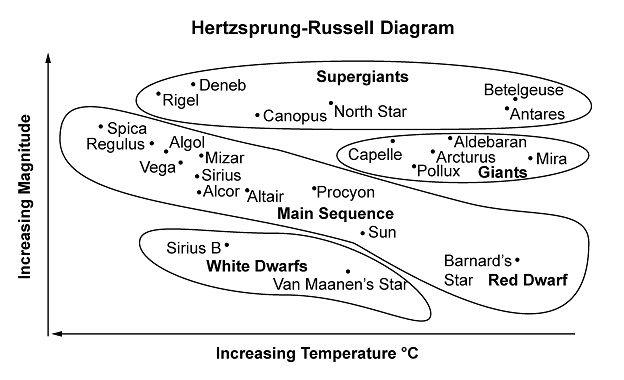
Quiz Review - phases/tides/stars/H-R
Quiz by Maribel Garcia
Feel free to use or edit a copy
includes Teacher and Student dashboards
Measure skillsfrom any curriculum
Measure skills
from any curriculum
Tag the questions with any skills you have. Your dashboard will track each student's mastery of each skill.
With a free account, teachers can
- edit the questions
- save a copy for later
- start a class game
- automatically assign follow-up activities based on students’ scores
- assign as homework
- share a link with colleagues
- print as a bubble sheet
20 questions
Show answers
- Q1What do our sun and the star Vega have in common?both have the same magnitudeboth are part of the same solar systemboth are main sequence starsboth have the same temperature60s
- Q2Around 1910, two astronomers named Hertzsprung and Russell discovered a relationship that the stars in the main sequence have in common. What is this relationship?stars with greater temperatures tend to have lower magnitudesstars with greater masses tend to have lower temperaturesstars with greater magnitudes tend to have lower temperatuesstars with greater magnitudes tend to have higher temperatures60s
- Q3Nick's teacher explained that there are certain objects that most likely exist at the center of every galaxy. These objects are so dense that their gravitational fields suck everything in, including light. They form when a galxy or star collapses under the pull of its own gravity. Nick knows that these objects are called-blue giantsblack holesquasarsnebulae60s
- Q4Which statement about the universe is correct?it is gradually getting smallerit is made up mostly of empty spaceit is known as the Milky Wayit consist of one Sun, nice planets, and satellites60s
- Q5What is the correct series of phases from a full moon to a new moon?waxing gibbous, third quarter, waning crescentwaxing gibbous, third quarter, waxing crescentwaning gibbous, first quarter, waxing crescentWaning gibbous, third quarter, waning crescent60s
- Q6What is the correct series of phases from a third quarter moon to a first quarter moon?waxing crescent, new moon, waning crescentwaning gibbous, full moon, waxing gibbouswaxing gibbous, full moon, waning crescentwaning crescent, new moon, waxing crescent60s
- Q7Before a New Moon becomes a full moon, it must go through the -waxing crescent and waxing gibbous phaseswaning crescent and waning gibbous phaseswaning crescent and first quarter phasesfirst quarter and third quarter phases60s
- Q8Only a small part of the moon's visible surface is lit following the new moon. The moon is in its -first quarter phasefull moon phasewaxing crescent phasewaning crescent phase60s
- Q9Before a full moon becomes a new moon, it must go through the -waning gibbous and third quarter stageswaning gibbous and waxing crescent stagesthird quarter and waxing crescent phaseswaxing gibbous and waning crescent phases60s
- Q10Nearly all of the Moon's visible surface is lit following a full moon. What is the name for this phase of the Moon?waning crescent phaseWaning gibbous phasenew moon phasewaxing gibbous phase60s
- Q11It takes the Moon about 29 days to complete a full lunar cycle. Since the length is not exactly 30 days, about every three years, there will be -one gibbous moon in one monthone crescent moon in one monthtwo full moons in one monththree third quarter moons in one month60s
- Q12The position of the Moon is causing -low tides to occur on both sides of Earth where the ocean bulge outwardhigh tides to occur on both sides of Earth where the oceans bulge outward.a high tide to occur only on the side of Earth that faces the Moona low tide to occur only on the side of Earth that faces the sun60s
- Q13Diagram shows the Earth, the Moon, and the Sun during Spring Tides. At new moons and full moons, Earth, the Moon, and the Sun are aligned. This means that when there are new moons and full moons, high tides on Earth are-unusually highunusually loweverywhere simultaneouslyat their average height60s
- Q14A tide with the largest difference between water levels at high and low tides is known as a spring tide. Two spring tides occur in each lunar cycle. This is because a spring tide occurs when the moon -is closest to the Earthis farthest from Earthand the Sun are aligned and pull on Earthand the Sun pull on Earth at a 90* angles60s
- Q15An astronomer detects a star with a temperature of about 15,000 kelvin (K) and a luminosity of about 1.0 solar units. Based on the Hertzsprung-Russell diagram, what type of star has the astronomer detected?a supergianta main sequence stara white dwarfa giant60s
